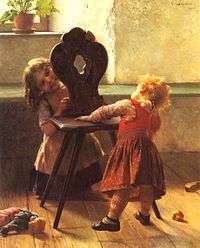Peekaboo

Peekaboo (also spelled peek-a-boo) is form of play primarily played with an infant. To play, one player hides his or her face, pops back into the view of the other, and says Peekaboo!, sometimes followed by I see you! There are many variations: for example, where trees are involved, "Hiding behind that tree!" is sometimes added. Another variation involves saying "Where's the baby?" while the face is covered and "There's the baby!" when uncovering the face.
Peekaboo uses the fundamental structure of all good jokes - surprise, balanced with expectation.[1]
Peekaboo is thought by developmental psychologists to demonstrate an infant's inability to understand object permanence.[2] Object permanence is an important stage of cognitive development for infants. In early sensorimotor stages, the infant is completely unable to comprehend object permanence. Psychologist Jean Piaget conducted experiments with infants which led him to conclude that this awareness was typically achieved at eight to nine months of age. Infants before this age are too young to understand object permanence. A lack of Object Permanence can lead to A-not-B errors, where children reach for a thing at a place where it should not be.
See also
| Look up peekaboo in Wiktionary, the free dictionary. |
References
- ↑ Stafford, Tom. "Why All Babies Love Peekaboo", BBC, April 18, 2014
- ↑ David Mayers, "Exploring Psychology, 2011"
Further reading
- Bruner, J. S. & Sherwood, V. (1976). "Peek-a-boo and the learning of rule structures". In Bruner, J.; Jolly, A. & Sylva, K. Play: Its Role in Development and Evolution. Middlesex: Penguin. pp. 277–287. ISBN 0-14-081126-5.